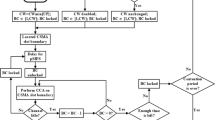Abstract
The role of IEEE 802.11 wireless local area networks (WLANs) become vital due to its low cost deployment and the aspiration to improve its performance has become the need of the day. Among existing challenges the most prominent are success ratio, packet loss ratio, collision rate, fairness index, and energy consumption, advances in wireless technologies stress to surmount these challenges. To attain these, performance enhancement, genetic fuzzy-contention window optimization (GF-CWO) approach, is proposed which combined the fuzzy logic controller (FLC) and genetic algorithm (GA), through this way GA optimally tuned the FLC. For this purpose three alogrithms are proposed, namely Algorithm-1: GF-CWO for WLANs, Algorithm-2: GA for GF-CWO, and Algorithm-3: FLC for GF-CWO. Proposed GF-CWO approach is tested for binary exponential back-off (BEB), selected being a de facto standard algorithm, and for Channel Status based Sliding Contention Window (CS-SCW) algorithm, selected being a fuzzy logic based algorithm, implemented in MATLAB. Recorded the resultant values for 5, 10, 15, 20, 25, 30, 35, 40, 45, 50 nodes in different files for BEB, CS-SCW, and GF-CWO, respectively. Later on these files were used to evaluate success ratio, packet loss ratio, collision rate, fairness index and energy consumption and also generated the results graphically. The results generated through simulated test confirmed that the GF-CWO has effectively enhanced the performance.

















Similar content being viewed by others
References
Committee ICSLMS et al. (2016) IEEE standard for information technology—Telecommunications and information exchange between systems local and metropolitan area networks—Specific requirements—Part 11: Wireless lan medium access control (MAC) and physical layer (PHY) specifications. IEEE Std 80211-2016 (Revision of IEEE Std 80211-2012).
Bianchi, G. (2000). Performance analysis of the IEEE 802.11 distributed coordination function. IEEE Journal on Selected Areas in Communications, 18(3), 535–547.
Hoang, T. M., Bui, V. K., & Nguyen, T. T. (2017). The performance evaluation of an IEEE 802.11 network containing misbehavior nodes under different backoff algorithms. Security and Communication Networks, 2017, 1–8.
Lei, J., Wang, Y., & Yun, H. (2020). Decoupling-based channel access mechanism for improving throughput and fairness in dense multi-rate WLANS. Future Internet, 12(1), 3.
Lei, J., Tao, J., Huang, J., & Xia, Y. (2019). A differentiated reservation mac protocol for achieving fairness and efficiency in multi-rate IEEE 802.11 WLANS. IEEE Access, 7, 12133–12145.
Zhong, Z., Kulkarni, P., Cao, F., Fan, Z., & Armour, S .(2015) . Issues and challenges in dense wifi networks. In 2015 International Wireless Communications and Mobile Computing Conference (IWCMC) (pp. 947–951). IEEE.
Zhao, Q., Xu, F., Yang, J., & Zhang, Y. (2017). CSMA/CQ: A novel SDN-based design to enable concurrent execution of channel contention and data transmission in IEEE 802.11 networks. IEEE Access, 5, 2534–2549.
Chun, S., Xianhua, D., Pingyuan, L., & Han, Z. (2012). Adaptive access mechanism with optimal contention window based on node number estimation using multiple thresholds. IEEE Transactions on Wireless Communications, 11(6), 2046–2055.
Al-Hubaishi, M., Alahdal, T., Alsaqour, R., Berqia, A., Abdelhaq, M., & Alsaqour, O. (2014). Enhanced binary exponential backoff algorithm for fair channel access in the IEEE 802.11 medium access control protocol. International Journal of Communication Systems, 27(12), 4166–4184.
Patel, P., & Lobiyal, D. K. (2015). A simple but effective contention aware and adaptive back-off mechanism for improving the performance of IEEE 802.11 DCF. Wireless Personal Communications, 83(3), 1801–1841.
Syed, I., & Roh, B. (2016). Adaptive backoff algorithm for contention window for dense IEEE 802.11 WLANS. Mobile Information Systems, 2016, 1–11.
Zhou, X., Zheng, C., & Liao, M. (2016). Full-feedback contention window adaption for IEEE 802.11 WLANS. Journal of Systems Engineering and Electronics, 27(1), 90–98.
Shurman, M., & Al-Shua’b, B. (2016). N-beb: New binary exponential back-off algorithm for IEEE 802.11. Adhoc & Sensor Wireless Networks, 32, 301–317.
Zhang, C., Chen, P., Ren, J., Wang, X., & Vasilakos, A. V. (2017). A backoff algorithm based on self-adaptive contention window update factor for IEEE 802.11 DCF. Wireless Networks, 23(3), 749–758.
Hanzawa, T., & Kimura, S. (2017). A minimum contention window control method for lowest priority based on collision history of wireless LAN. International Journal of Networking and Computing, 7(2), 295–317.
Karaca, M., Bastani, S., & Landfeldt, B. (2017). Modifying backoff freezing mechanism to optimize dense IEEE 802.11 networks. IEEE Transactions on Vehicular Technology, 66(10), 9470–9482.
Choi, J., Byeon, S., Choi, S., & Lee, K. B. (2017). Activity probability-based performance analysis and contention control for IEEE 802.11 WLANS. IEEE Transactions on Mobile Computing, 16(7), 1802–1814.
Nithya, B., Mala, C., & Sivasankar, E. (2017). Channel status based sliding contention window (cs-scw) algorithm: A fuzzy control approach for medium access in wireless networks. Soft Computing, 21(8), 1991–2004.
Lee, M. W., & Hwang, G. (2018). Adaptive contention window control scheme in wireless ad hoc networks. IEEE Communications Letters, 22(5), 1062–1065.
Cai, X., Li, B., Yang, M., Yan, Z., Yang, B., Jin, Y., & Li, X. (2018). Fractional backoff algorithm for the next generation WLAN. In International wireless internet conference (pp. 24–31). Springer.
Cheng, Y., Zhou, H., & Yang, D. (2019). Ca-CWA: Channel-aware contention window adaption in IEEE 802.11 ah for soft real-time industrial applications. Sensors, 19(13), 3002.
Author information
Authors and Affiliations
Corresponding author
Ethics declarations
Conflicts of interest
Authors declare that they have no conflicts of interest.
Human and animal rights
This article does not contain any studies with human participants or animals performed by any of the authors.
Additional information
Publisher's Note
Springer Nature remains neutral with regard to jurisdictional claims in published maps and institutional affiliations.
Rights and permissions
About this article
Cite this article
Qureshi, I.A., Asghar, S. A genetic fuzzy contention window optimization approach for IEEE 802.11 WLANs. Wireless Netw 27, 2323–2336 (2021). https://doi.org/10.1007/s11276-021-02572-8
Accepted:
Published:
Issue Date:
DOI: https://doi.org/10.1007/s11276-021-02572-8




